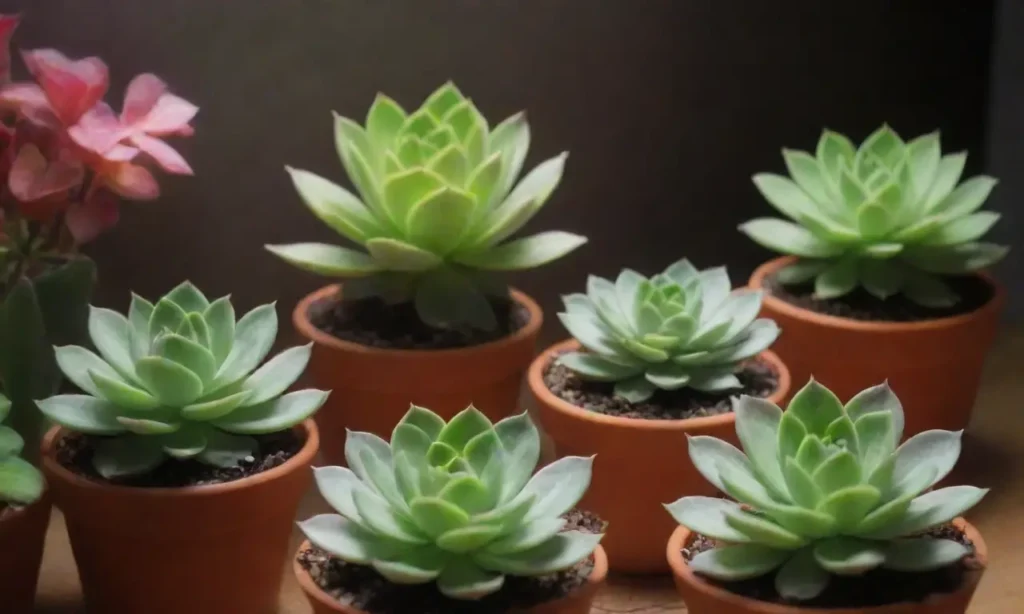Best Grow Lights for Succulents: LED vs. Fluorescent Explained

Introduction
Succulents are cherished by many for their stunning diversity and low-maintenance nature. These hardy plants thrive in well-draining soil and require bright, indirect light to flourish. However, not everyone has access to an ideal growing environment filled with natural sunlight, particularly during winter months or in regions with limited daylight. This has led many plant aficionados to explore supplemental lighting options to ensure their beloved succulents receive the light they need.
In this article, we will delve into the two most popular types of grow lights: LED and fluorescent. We will explore their characteristics, advantages, and disadvantages, helping you make an informed decision on which lighting option is best suited for your succulents. By the end of this article, you will have a comprehensive understanding of how to provide the best light conditions for your plants, enhancing their growth and overall health.
The Growth Needs of Succulents
Understanding Succulent Light Requirements
Succulents are adapted to thrive in harsh environments, often originating from arid deserts where the sun is bright and intense. They possess specialized structures known as CAM (Crassulacean Acid Metabolism), allowing them to efficiently process carbon dioxide during the night and minimize water loss during the day. However, even though succulents are resilient, they still require an adequate amount of light to promote healthy growth, vibrant colors, and blooming.
In general, succulents prefer bright light conditions for at least 6 to 8 hours per day. When light conditions are inadequate, the plants may become leggy, stretched out, or exhibit pale colors, known as etiolation. Hence, providing the right type of light is crucial for maintaining the health of your succulents, especially during winter or in darker indoor environments.
Signs of Insufficient Light
Recognizing signs of inadequate lighting can help you make timely adjustments to your succulent care routine. Among the most common symptoms are:
Leggy Appearance: If your succulents are growing tall and elongated rather than maintaining their compact forms, it is a clear indication that they are stretching for light.
Pale Leaves: Healthy succulents typically display vibrant colors. If their leaves start to lose their color and appear washed out, they may not be receiving enough light.
 The Role of Light Spectrum in Succulent Photosynthesis Explained
The Role of Light Spectrum in Succulent Photosynthesis ExplainedReduced Growth: Stunted growth or little to no new leaves can signal that your succulents require additional light to thrive.
By understanding these signs, you can make necessary interventions, potentially equipping your growing space with effective lighting solutions.
LED Grow Lights
Overview of LED Grow Lights
LED grow lights have gained immense popularity among plant enthusiasts due to their energy efficiency, longevity, and flexibility in light spectrum options. LED, or light-emitting diode, technology has evolved significantly, offering full-spectrum lights that replicate natural sunlight, which is beneficial for plant growth. Typically, these lights emit significantly lower heat than traditional lighting options, reducing the risk of overheating your plants.
One of the standout features of LED grow lights is their ability to produce different wavelengths of light. Plants mostly absorb red and blue light, necessary for the processes of photosynthesis. LEDs can be designed to emit specific wavelengths, allowing you to customize the light spectrum according to your plants’ developmental stage. For instance, blue light is preferred during the vegetative phase, while red light enhances flowering and fruiting.
Advantages of LED Grow Lights
The numerous advantages of LED grow lights make them an attractive option for succulent care. Firstly, they consume less energy compared to fluorescent lights, equating to lower electricity bills over time and making them environmentally friendly. Secondly, the longevity of LEDs is remarkable; they can last up to 50,000 hours or more, which reduces replacement costs and waste.
Furthermore, the low heat output means that you can place LED lights closer to your succulents without the risk of scorching or damaging them. This is particularly beneficial if your indoor space has limited height or if you want to maximize the amount of light reaching your plants. Lastly, many LED grow lights come with adjustable settings, allowing you to toggle between different wavelengths depending on the growth stage of your succulents.
Disadvantages of LED Grow Lights
Despite their benefits, it's essential to consider some potential downsides to LED grow lights. The initial cost can be higher than fluorescent options, deterring some individuals from making the switch. Although prices have dropped in recent years, a high-quality LED system may require a more significant investment upfront.
 Educational Insights into the Photosynthetic Process of Succulents
Educational Insights into the Photosynthetic Process of SucculentsAnother factor to keep in mind is the light intensity. While LEDs provide higher quality light, some plants might require a stronger light output. Therefore, individuals must choose LEDs that offer adequate wattage for their specific plant needs. Lastly, LED lights can sometimes cause plants to become overly reliant on artificial light, leading to challenges in acclimating them to natural sunlight if they're moved outdoors. Proper transitioning techniques need to be applied to avoid shock.
Fluorescent Grow Lights

Overview of Fluorescent Grow Lights
Fluorescent grow lights have been a staple in indoor gardening due to their affordability and effectiveness. These lights utilize gas-filled tubes to produce light and come in a variety of forms, including T5, T8, and T12 bulbs. Each type represents a difference in size and energy consumption, with T5 bulbs generally being the most efficient and compact option available for plant growth.
Fluorescent lights release a broad spectrum of light and are particularly effective at emitting blue light, making them suitable for the vegetative growth phase. Additionally, fluorescent lights come in full-spectrum options that mimic natural sunlight, supporting various plant stages, from growth to blooming.
Advantages of Fluorescent Grow Lights
One of the significant advantages of fluorescent lights is their affordability. They are generally cheaper to purchase than LED lights, making them an appealing option for beginners or those on a budget. Furthermore, fluorescent lights are available in several sizes and configurations, which can be conveniently arranged in your growing space to enhance coverage for your succulents.
Fluorescent grow lights also emit minimal heat, allowing them to be placed closer to the plants without causing burns or damage. This quality makes them suitable for small or confined indoor areas where spacing is an issue. Lastly, the light produced can cover a significant area, making them a good option if you're growing multiple plants at once.
Disadvantages of Fluorescent Grow Lights
On the flip side, fluorescent lights come with their own set of challenges. While they are energy-efficient, they generally consume more energy than LED lights over time, which can lead to higher electricity costs in the long run. Their lifespan is also shorter compared to LEDs, typically lasting around 10,000 to 20,000 hours before requiring replacement.
The light produced by fluorescent bulbs can sometimes lead to an “ugly” yellow tint, which might not be appealing in terms of aesthetics. Additionally, while fluorescent lights provide adequate lighting for vegetative growth, they may fall short when it comes to promoting flowering or fruiting, especially for more mature plants. Selecting the right wattage and type of bulb is crucial for meeting the needs of your succulents.
What to Consider When Choosing Grow Lights
Determining Space and Size Needs
Before making a decision between LED and fluorescent grow lights, it is crucial to assess your growing space. Understanding the size of your plants and the number you intend to grow will guide you in selecting the right setup. If you have limited space, opting for compact LED fixtures may be advantageous, allowing you to maximize light without taking up too much room. Alternatively, fluorescent bulbs can be arranged in a manner that provides square footage coverage.
Evaluating Intensity and Spectrum
The intensity of light is paramount in sustaining healthy plants. Determine the light requirements of your specific succulent species and select grow lights that can meet those needs effectively. You may also need to factor in the ability to modify light spectrum settings, particularly if you are planning to grow succulents from various genera with differing light demands.
Budget Consideration
Lastly, budget plays a significant role in choosing the appropriate grow lights. While LED lights may be more expensive initially, their long-term benefits in energy savings and longevity can outweigh short-term savings from fluorescent options. Hence, it's best to evaluate your budget while considering your commitment to growing succulents for the long haul.
Conclusion
In conclusion, both LED and fluorescent grow lights offer unique advantages and disadvantages for succulent care. LED grow lights stand out for their energy efficiency, customizable light spectrums, and long lifespan, making them a popular choice in the gardening community. However, they do come with a higher upfront cost and potential challenges with light intensity for specific plants.
On the other hand, fluorescent lights are an accessible option for budding plant parents, offering affordability and broad coverage. They emit light that is often conducive to vegetative growth but may fall short in promoting flowering stages for certain types of succulents.
Ultimately, the best choice depends on your personal preferences, the space you have available, your budget, and the specific needs of your succulent collection. By carefully weighing these options, you’ll be better equipped to create a flourishing environment that supports the beauty and vitality of your beloved succulents. With the right grow lights, you can enjoy the delightful experience of watching your plants thrive indoors, bringing life and color into your home year-round.
If you want to read more articles similar to Best Grow Lights for Succulents: LED vs. Fluorescent Explained, you can visit the Light Requirements category.
